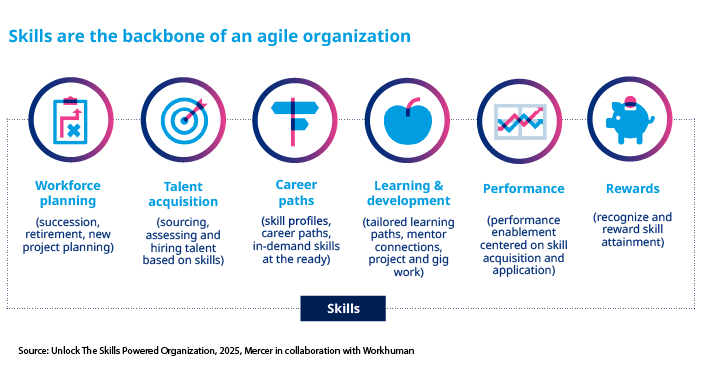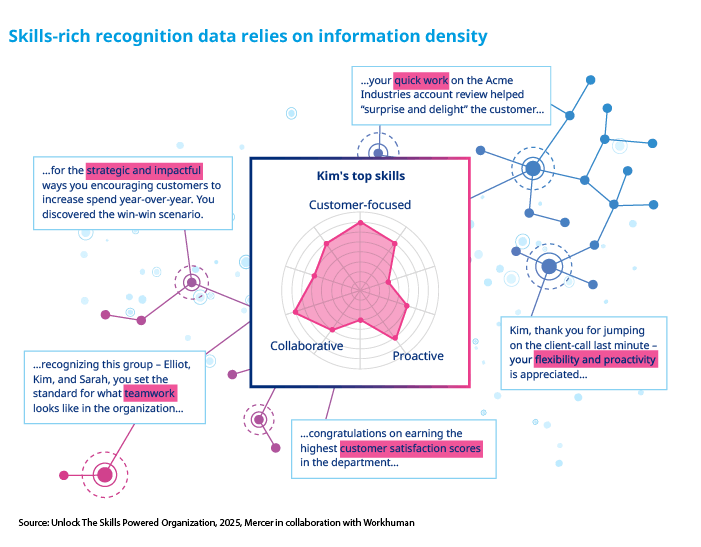Unlocking the Skills-Based Organization with Recognition Data
Table of contents
- What does it mean to be a skills-based organization?
- Why skills assessments need to be at the center of your HR strategy
- Traditional barriers to understanding the skills ecosystem
- How recognition data unlocks true skills intelligence
- From insight to action: how Workhuman powers skills strategy
- Take the first step toward a skills-based strategy
Organizations are navigating a relentless pace of change driven by AI innovation, economic uncertainty, and shifting workforce expectations. To stay ahead, resilience isn’t enough. Workforce agility is the new competitive advantage.
A growing number of HR leaders are embracing a skills-based organization model to meet this challenge, shifting from rigid job descriptions to dynamic, skills-based talent strategies. But making this transition successfully requires more than intention: it demands better skills data.
Let’s explore why adopting a skills-based approach is vital for organizations navigating a future defined by constant change.
What does it mean to be a skills-based organization?
According to a new report from Mercer in collaboration with Workhuman®, an organization is skills-powered when they “…prioritize the unique talents and capabilities of their workforce, moving away from rigid job descriptions to embrace flexibility and focus on what individuals can do to contribute to the organization’s success, while simultaneously empowering career growth.”
Read more about what it means to be skill-powered, and how recognition unlocks your path to it, in our latest report.
A skills-based talent strategy focuses on what people can do, not just their job titles.
As organizations embrace this shift, many are turning to a talent marketplace model: one that allows them to dynamically match people with projects based on real-time skill data. By organizing work around both soft and technical skills, these internal marketplaces promote agility, unlock internal mobility, and reduce the need for external hiring.
Why skills assessments need to be at the center of your HR strategy
As the workplace has evolved, so have workers’ needs. Rigid jobs and role descriptions that used to help align companies with the right talent now do more to create noise and friction than progress. To survive, HR needs to rely on strategy and data as they face talent shortages and skill gaps.
In fact, Mercer found that a staggering 79% of C-suite executives recognize the need for greater agility in talent processes to pivot their workforce in response to changing market demands. Currently, 48% of HR leaders have created a skills library to better understand their workforce's capabilities.
As skills change faster than job titles, organizations need to be nimble, constantly checking in on the skill sets they have and what they’ll need moving forward. Organizations need to pivot to skills-based talent management to stay afloat as they are the backbone of an agile organization.

This shift also enables more effective strategic workforce planning, allowing HR leaders to anticipate future talent needs and identify gaps in relevant skills before they become critical. Instead of reacting to change, organizations can proactively align their talent strategies with evolving business goals.
Benefits of a skills-based approach
Organizations that prioritize skills over traditional job roles are outperforming their peers in several key areas.

A skills-first approach also opens the door to more equitable and efficient skills-based hiring. Rather than filtering candidates by rigid job histories or degree requirements, organizations can focus on the actual capabilities needed for success. This leads to more inclusive talent pipelines and better job-fit outcomes.
With a clearer understanding of their workforce's capabilities, these companies can match the right skills to the right tasks, enhancing operational efficiency and improving talent acquisition efforts. When organizations know what skills they need, they can attract candidates who fit those requirements more accurately, or better yet, find them internally. In fact, 55% of skills-based organizations report improved sharing of talent across departments, fostering cross-functional collaboration and better employee development opportunities.
By organizing work around skills rather than rigid job descriptions, companies unlock the full potential of their employees, resulting in greater job satisfaction, a more engaged workforce, and enhanced profitability. The focus on skills isn’t a trend, it’s a strategic move that drives real results for organizations.
Traditional barriers to understanding the skills ecosystem
One of the biggest challenges becoming a skills-based organization is understanding and validating employee skills. To get a complete picture of skills, organizations also need to evaluate skill proficiency (also known as skill ratings or competencies), which indicates how well employees utilize their skills.
Traditional methods for gathering skills data are often flawed, creating gaps that could hinder progress. Mercer research shows that less than half (48%) of employees feel their skills are valued by their organization, highlighting the disconnect between the skills-powered world most organizations want, and the stark realities they face in creating it.
A major issue with skill identification is the reliance on self-reported skills. While this encourages employees to think about their current skills, it’s subjective and depends on them accurately assessing their own abilities, meaning the results can be unreliable. As a result, fewer than 25% of HR teams believe they can use this data for compensation or career progression.
On one end of the spectrum, we have the Dunning-Kruger effect—a cognitive bias where people who aren’t skilled in a certain area overestimate their abilities, thanks to what they don’t know. On the other end, we have Imposter Syndrome—high-performers who are sure that they’re faking it, undervaluing and downplaying the expertise they possess.

Manager-validated skills introduce their own errors. Managers are often busy and may not have the time to keep up with their team's skills. Plus, they aren't involved in every project or interaction, which means they can miss chances to spot transferable or emerging skills. Not to mention, both self-reported and manager-validated skills can introduce unwanted biases.
Lastly, many skills are hidden, creating gaps in skills visibility, making it harder for organizations to fully tap into their workforce's potential.
How recognition data unlocks true skills intelligence
Recognition draws on authentic human interactions, and when these interactions are captured frequently, in detail, from people around the organization, it leads to real-time, organic insights into the workforce’s skills.
By using AI to mine this human-powered recognition data, organizations can access a new form of previously untapped intelligence: what Workhuman refers to as Human Intelligence™, which combines human data and AI.

This skills-rich data is crucial for validating employee capabilities, providing real-time, objective insights that reflect skills as they are demonstrated through real work experiences. By capturing existing skills in action, it highlights their practical application, rather than just theoretical knowledge. Observing how employees apply their skills in real situations gives organizations a clearer picture of their true capabilities.
Over time, this insight creates a dynamic feedback loop for skills development. Employees gain visibility into the capabilities they’re recognized for, which helps them build on strengths and target growth areas. For HR, it means access to organic, real-time signals about where to invest in upskilling efforts.
When it comes to skills, we need to focus on results, which is why I love the recognition piece. To get recognized, there had to have been a good result, and a result you want to repeat. And coming from people who have no incentive other than to recognize you for a job well done, that avenue is starting to show validation of skills, especially of softer human skills.
To harness the full potential of recognition data, organizations must focus on creating recognition programs that are:
- Contextual: Recognition messages should be descriptive to reveal valuable insights and personalized to uncover individual strengths instead of making generic assumptions.
- Frequent: Recognition shouldn’t be reserved just for the moments where someone goes “above and beyond,” but in everyday moments where employees show up and deliver.
- Meaningful: Rewards should reflect the effort and impact of skills, highlighting skills in action rather than just in theory.
- Organic: Authentic feedback is key to capturing skills data effectively and ensuring both the giver and receiver feel the impact.
- Far-reaching: Recognition must be fair and accessible to all employees.
It’s this type of recognition programs and data that unlock the skills-based organization.
Learn how to build a skill-powered organization with recognition data in our latest report.
From insight to action: how Workhuman powers skills strategy
Human Intelligence is AI-driven program optimization and advanced people and business insights derived by mining the human data of Social Recognition® with Workhuman’s revolutionary AI tools, including Workhuman® iQ and it's core feature, the AI Assistant.
Utilizing the power of proprietary algorithms developed by our team of data scientists and researchers, combined with AI:
- HR and talent managers can gain insights into skills and future cultural trends for better internal mobility, training, and succession planning.
- People leaders can answer key questions around skills, mentorship matching, and more, driving performance across their teams.
Don't just take our word for it. Here's Josh Bersin, research analyst, author, and thought leader focusing on global talent market challenges and trends impacting workforces around the world, speaking to the critical role of Human Intelligence in addressing the skills gap.
Take the first step toward a skills-based strategy
Becoming a skills-based organization doesn’t happen overnight, but recognition data offers a practical and powerful starting point. When you make recognition strategic, consistent, and meaningful, you’re not just boosting morale, you’re unlocking vital insights into your workforce’s true capabilities.
Ready to transform your workforce?